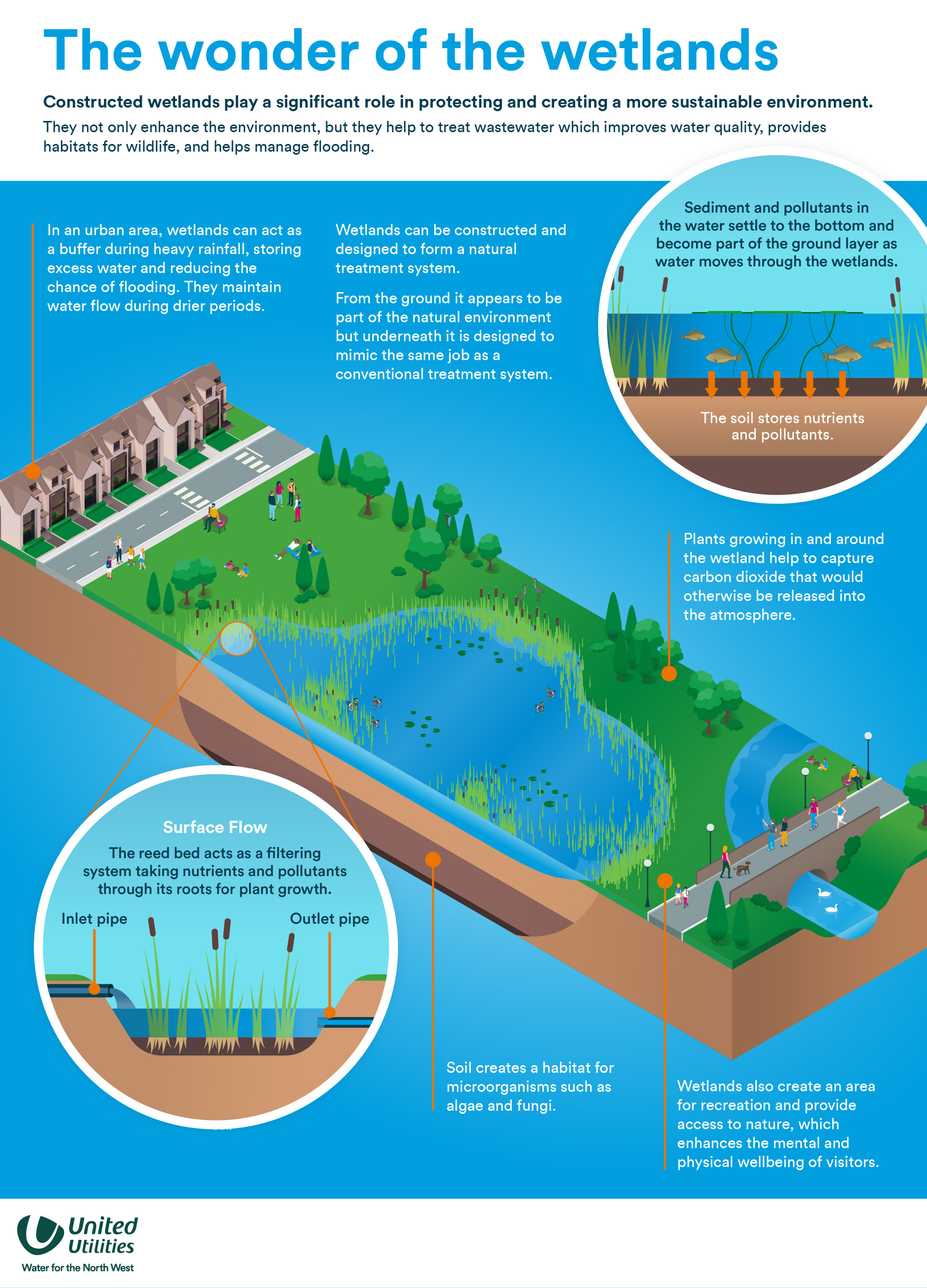The wonder of the wetlands
Existing as one of the most sustainable solutions to the treatment of wastewater, while also protecting against water running off the surface of the land after a period of excessive rainfall, constructed wetlands are specifically designed ecosystems that feature algae, aquatic vegetation, micro-organisms and organic soils.
Alongside treating wastewater, wetlands improve the overall quality of water, provide thriving habitats for wildlife, and help manage flooding.
Constructed wetlands are created in a way that mimics that of a natural wetland - and they carry out a very similar role which is to encourage the interaction between plants, the soil and organisms.
There’s more than one type of wetland
There are two main types of wetland – free water surface flow wetlands and subsurface flow wetlands. Both are great solutions that United Utilities are looking to adopt in the best possible locations.
In free water surface flow wetlands, the system is designed to keep water above ground. However, in subsurface flow wetlands (the clue is in the name) the water level is kept below ground.
Across the globe, the vegetation and makeup of a wetland varies. In the UK, wetlands are often known as reed beds because of the use of the common reed in treating the wastewater. The reed absorbs water, nutrients, and pollutants up through its roots.
In this article, we’re exploring just how a constructed wetland works, why we’re so enthusiastic about using them when we can, and how they fit into our Catchment Systems Thinking (CaST) approach – an innovative approach to the management of water that goes beyond looking at the land and delves into the wider environment.
What wetlands can do
The capabilities of constructed wetlands are incredible.
Of course, being able to improve water quality in the way in which nature intended is the over-arching benefit of the wetlands. But, thanks to their low maintenance and implementation efforts, they are also cost-effective, making them that little bit more special!
Wetlands also exist as the first line of flood defence, slowing down the flow of water during periods of heavy rainfall – which is particularly important as the world continues to battle the effects of climate change.
The plants and animals that make the wetlands their home are in abundance, and providing a habitat for this wildlife is undoubtedly one of the biggest benefits.
They also create an area of recreation and green open space which encourages access to nature and can drive improvements in people’s physical and mental health, as well as improving the environment around which we live. The experience of the Covid pandemic has almost certainly highlighted the value brought by being in the great outdoors and the ability to enjoy even the smallest bit of what Mother Nature has to offer.
Wetlands also blend in with the landscape, particularly when compared to grey infrastructure, and they are an environmentally conscious approach to water management, too.
So, how do the wetlands actually treat wastewater?
Water is fed into the wetland via an inlet pipe, and as the water is moving through, sediment and other pollutants drop down. They are effectively sieved and become part of the ground layer.
Nutrients and pollutants, which have not been removed by this stage, are taken up by the soil and vegetation. It is important, therefore, that the wetlands are rich in terms of plant and animal diversity, as both play a major role in terms of cleaning the water.
Suspended sediment, soils, and pollutants are all filtered out of the wastewater as it passes through the reeds. The pollutants settle and are removed, while molecules are absorbed as the water passes over the surface of the aquatic vegetation. Pollutants are broken down by the microorganisms.
The plants also assist in the capture of carbon dioxide, providing yet another overall benefit to the use of the wetlands. An impermeable layer at the base of the wetlands stops wastewater entering the groundwater and causing contamination.
At the other side of the wetland, once the biological, chemical, and physical processes have taken place and unwanted sediment has been removed, the water is distributed via an outlet pipe.
Each part of the wetlands has a role to play in ensuring the water delivered out the other side is of considerably higher quality.
Catchment Systems Thinking and wetlands
Catchment Systems Thinking is built upon applying the right intervention in the right place. When putting in place wastewater treatment solutions using a Catchment Systems Thinking approach, we don’t just consider the water quality at the end of the line, we think about everyone, every entity, and every habitat who interact with it!
Constructed wetlands may provide the best fit in many circumstances, but much like any solution, it won’t be appropriate in every instance. For this reason, we’re focused on making sure the right option delivers the broadest benefits to our customers and the wider catchment.
So, there you have it; the wonder of the wetlands…
Catchment Systems Thinking
Watch our video to learn more about Catchment Systems Thinking.